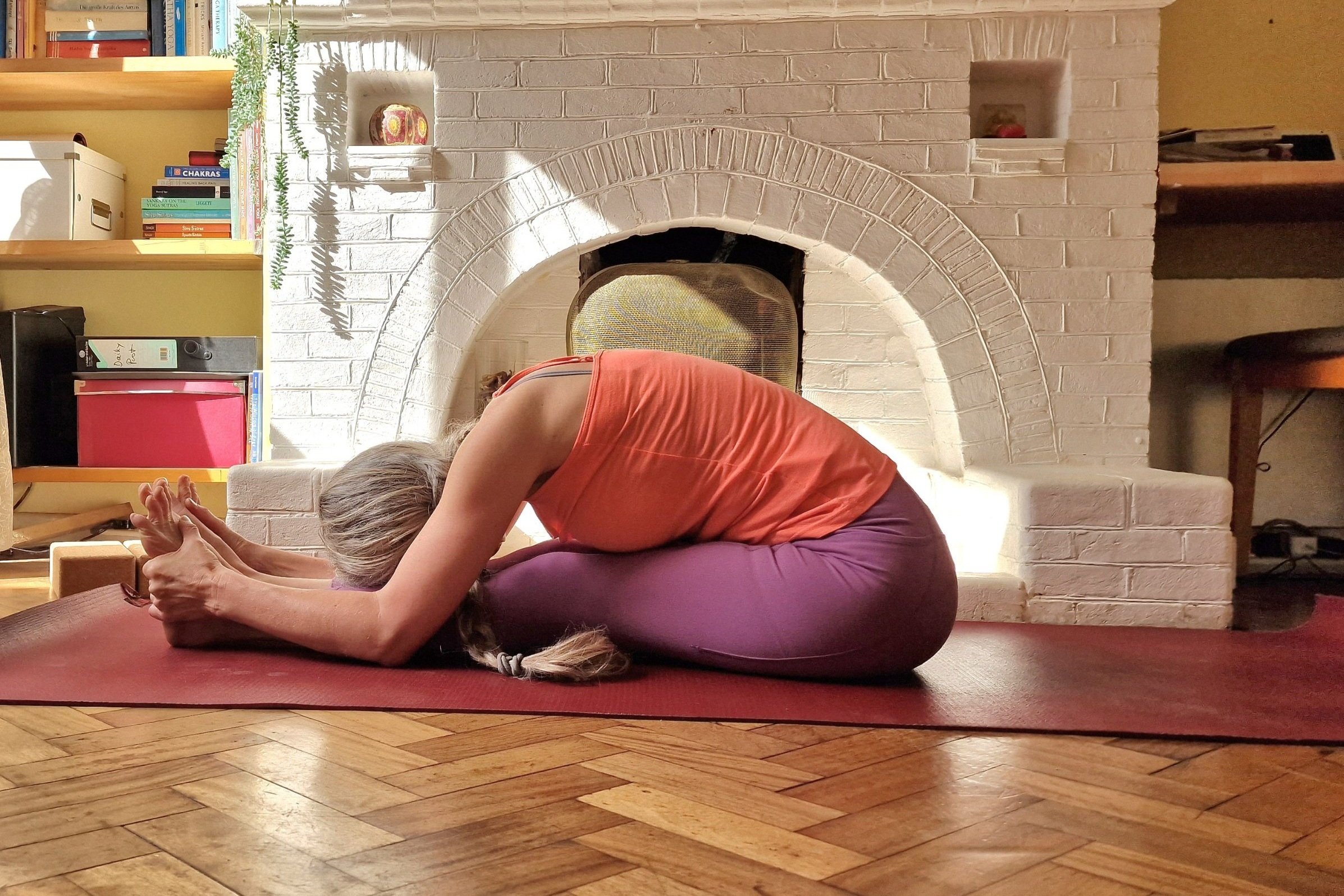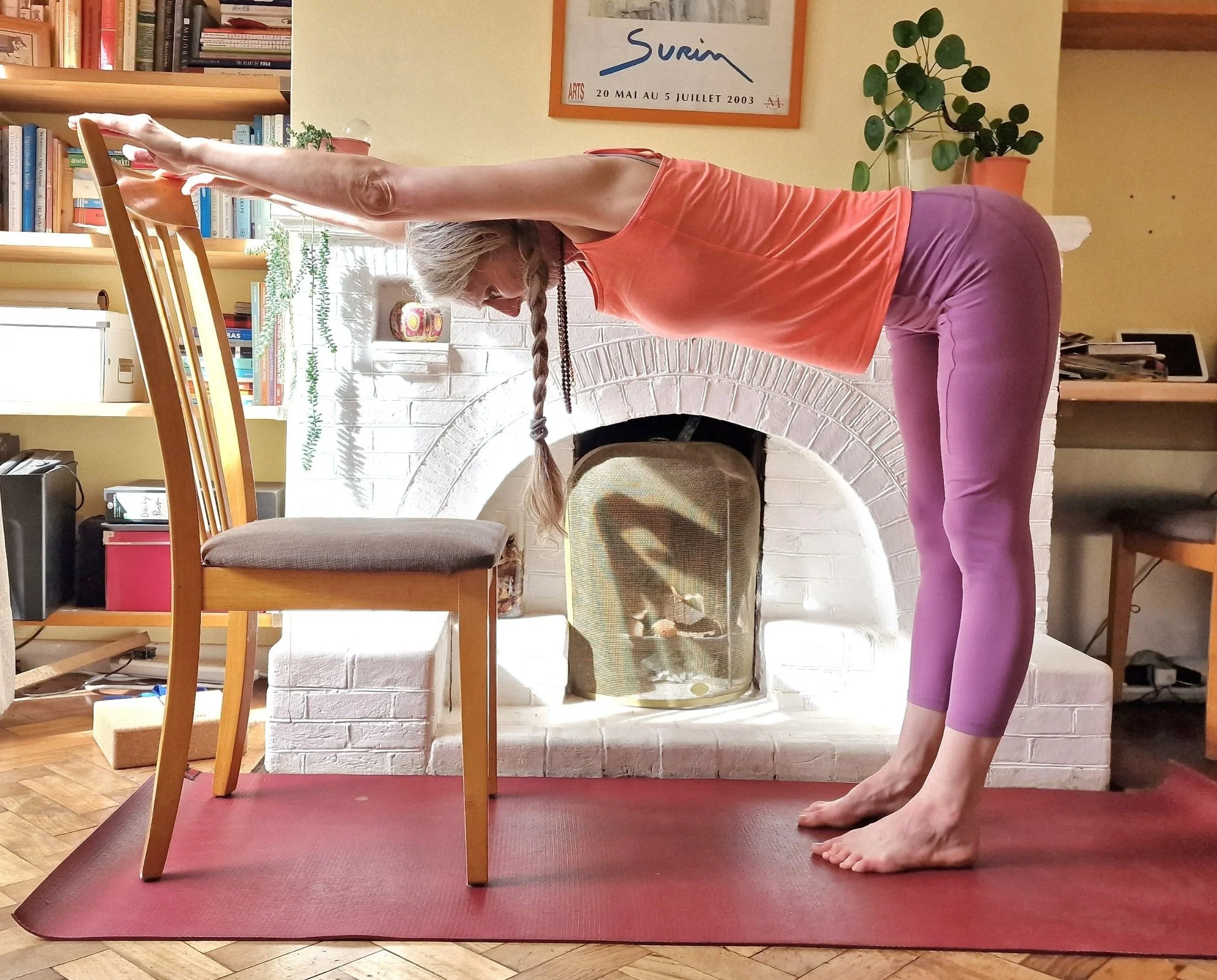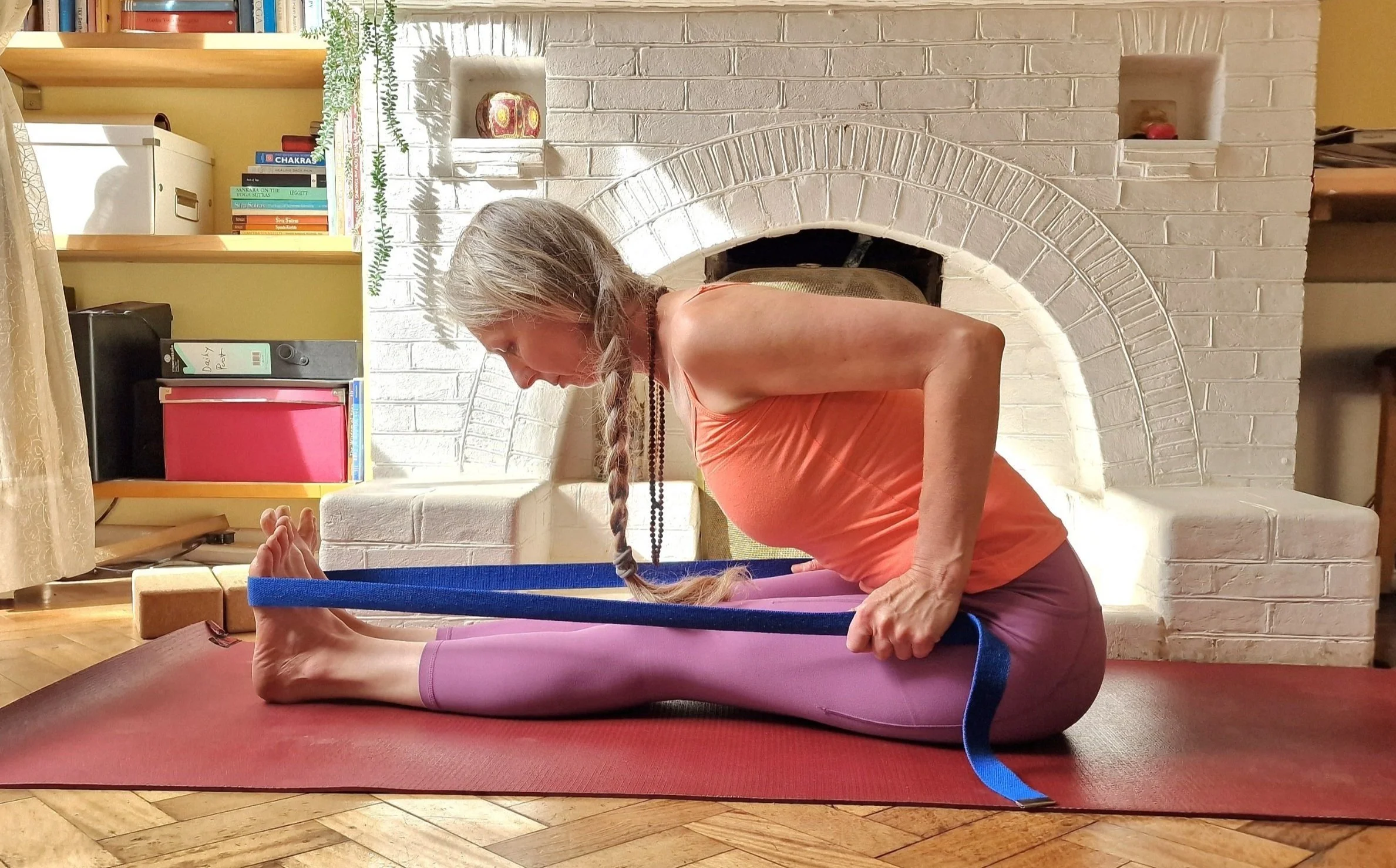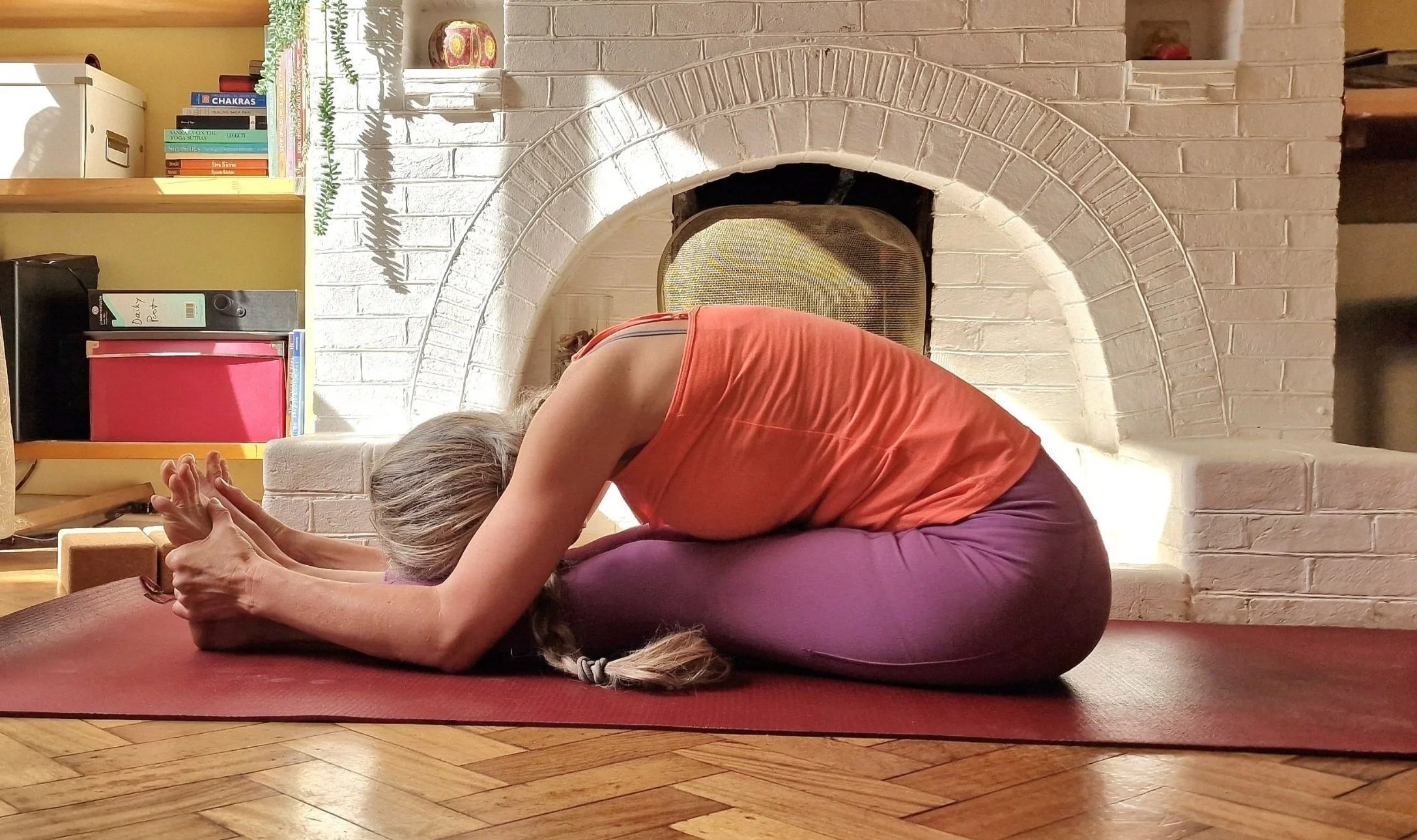Paschimottanasana - Calm your mind in the seated forward bend
Have you ever noticed becoming calmer when practising seated forward bend, or any forward bend for that matter?
The front of our body, with all its vital organs, is protected, and our more robust, less vulnerable back body is open.
Paschimottanasana is the Sanskrit word that translates as::
Paschima – West and - uttana intense stretch
Historically, we meant to face the sun when practising Yoga asana. And practise in the early morning. When bending forward facing the sun, our “west side”, the back of the body, lengthens and stretches, hence stretching its name.
For most of us, practising Paschimottanasana is a journey. Our west, the hamstrings and muscles of the back, need to lengthen big time. This requires time, patience, and perseverance. All good virtues to hone in on.
A heartfelt sigh fills the hall when I announce during class that we will enter Paschimottanasana. Nobody is looking forward to it. The pose challenges us in so many ways. Physically our hamstrings and back complain and we don’t enjoy spending much time in it.
This, alone, however, makes it such a brilliant pose for working on our self-development. We are:
Practising something that we dislike. One of Yoga’s aims is to overcome the likes and the dislikes and approach them with equanimity. So that’s a win-win here.
Practising a pose where progress might not show up quickly teaches perseverance or abhyasa is the concept of keep practising. Simultaneously, we have to let go of expectations, such as mastering the pose within a particular time frame, this is called vairagya. Abhyasa and vairagya is seen as two wings of a bird. Both need to be equally strong for it to fly.
You can see that the pose bears the potential for some deep work.
If more inspiration and motivation are needed, how about these more tangible benefits?
Create Healthy Eating Habits in 5 easy steps with our FREE 5-day email challenge.
Subscribe to our weekly Sunday Read newsletter & this Why Yoga & Ayurveda hold the Answer to everything Blog .
Why should we practise Paschimottanasana?
The benefits are many.
Lengthen the hamstrings and the muscles of the back.
Calms the mind.
Helps develop focus, patience, and resilience.
Aids digestion.
Here is a short excerpt of the Yoga Makaranda about the benefits of Paschimottanasana:
Benefit: This will cure all diseases related to the stomach. This asana can be done on the floor or on a mat according to the capabilities of one’s body. Learn some of the other forms of pascimottanasana krama by studying the pictures carefully. Pregnant women should not do this asana. But this can be done up to the third month of pregnancy. For men, there are no restrictions to practising this asana. If this is practised every day without fail for 15 minutes, all the bad diseases of the stomach will be removed.
Mr Yyengar also added to the benefits that it makes our stomach flat and is beneficial for the kidneys.
How to practise Seated Forward Bend?
Start here if you would like to learn how to practice the Seated Forward Bend yoga pose.
Sit in Dandasana or stick pose with the legs stretched out in front of you and the hands on either side of your hips or a little behind them to help lengthen the spine.
Inhale and lengthen through the spine.
Exhale, fold forward from your hips and imagine lifting over a rolled-up blanket placed at the very top of your thighs to avoid collapsing in the lower abdomen.
Bending forward is a movement of the pelvis; when you roll forward on your sit bones, the upper body stays long.
Inhale again, peel your upper body away from your legs.
Exhale fold forward again.
Place your hands where supportive; this can be
still behind you to help lengthen through the chest area.
Alongside your legs.
Thumb, index- and middle finger around the big toes.
Holding the outsides of the feet.
Interlace finger behind the foot soles.
Hold the pose by gently breathing deep into the abdomen, drawing the abdominal wall back with each outbreath.
Keep your legs active by drawing the toes towards the shins.
Hold the pose as long as it is comfortable. 5 deep breaths is a good start.
Keep the abdomen drawn back to exit the pose and lift the upper body with an inbreath.
How to make it easier?
As mentioned above, mastering the pose is a journey and offers the opportunity to develop patience, perseverance and resilience.
Standing is actually a great place to start easing the muscles into this intense stretch.
Place your hands on a table or chair and walk back as far as possible; lengthen your back and legs.
When this is comfortable, place your hands on a chair.
Practise Uttanasana, the standing forward bend, which has the same shape and movement pattern as the seated forward bend.
Sit on a block, with the pointy corner facing your feet.
Use a chair to support your upper body.
Bend your knees.
Use a belt. AVOID pulling yourself down forcefully. Instead, bend your elbow, keep your spine long, and roll forward on your sit bones.
Keep it dynamic: inhale, lengthen and exhale, fold forward, exhale back to upright, exhale forward, to practise the pelvic movement.
Throughout all the different stages, keep your breathing strong, breathe deep, and draw your abdomen or navel back with the outbreath.
How to challenge yourself?
You can challenge yourself with the hand positions mentioned earlier in the instruction part above.
Interlace your fingers behind your back.
Or add a twist to it.
Take it upside down.
The sky is the limit when considering the scop of practice with Paschimottanasana.
With Paschimottanasana through the Seasons
Paschimottanasana can is beneficial throughout the year. Here are some ideas on how you can adapt the practice for the different seasons.
Spring
As the body needs to work out more in the spring to overcome the heavy, slow and cold qualities, use the breath to keep the body warm and stimulate the digestive fire by breathing deep to the navel and with each outbreath draw the navel strongly back. Hold the pose with this active breathing for 10 breaths.
Summer
The warmth of the summer keeps the muscles warm, so this seated forward bend comes a little easier during the hot months. As we need to reduce intensity in this already intense season, keep it light. Let the breath flow down the back of your body and draw your navel gently back with the outbreath. A restorative version of supporting the head with the chair as above, or using a bolster or block to rest the upper body is a wonderful way to stay cool.
Autumn and Winter
Keep your breath focused, let the inbreath flow deep down to the lower back and the outbreath travel up the front of the body, drawing the navel gently back. This keeps the body warm, digestion strong and the mind focused. Experiment as well with focusing on the connection to earth underneath and its support when the mind is too active.
This way you can reap the benefits of Paschimottanasana all year round.
Let’s sum it up again
The blog post discusses the benefits and prapractised Paschimottanasana, a seated forward bend yoga pose.
Paschimottanasana: - known as the seated forward bend, this pose involves stretching the back of the body, particularly the hamstrings and the back muscles, often referred to as the "west side" of the body in the context of the pose.
Historically, this pose is practiced facing the sun, typically in the early mornings, aiding in calming the mind and focusing on self-development.
Benefits
It is beneficial for calming the mind and aids in focus, patience, and resilience development.
It also lengthens the hamstrings and the muscles of the back, aiding digestion.
Modifications
To make the pose accessible, several modifications and props like chairs, blocks, and belts can be used. Standing poses and focusing on dynamic movements with breathing can also aid in mastering this pose gradually.
Challenges
For advanced practitioners, hand positions like interlacing fingers behind the back can offer additional challenge and deepen the stretch.
Conclusion
Paschimottanasana, while challenging, offers a myriad of benefits and is versatile with modifications available for varying levels of practitioners. It not only brings tangible health benefits but also serves as a tool for self-development by fostering virtues like patience, perseverance, and resilience.
Enjoy your practice.
What is your favourite version of Paschimottanasana? Can you relate to the challenge the pose offers or does it come to you with ease? Let me know, You can leave a message on Instagram, Facebook or even good old email.
I love hearing from you!
Katja x
P.S. Did you know that healthy eating habits is supporting your asana practice?










